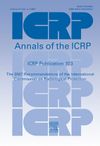Difference between revisions of "Dose limits"
(Created page with "<span style= "font-size:115%;"> '''Dose limits help ensure that no person is exposed to an excessive amount of [[ICRPædia Guide to the Basics of Ionising Radiation|radiation]...") |
(No difference)
|
Revision as of 20:52, 8 March 2019
Dose limits help ensure that no person is exposed to an excessive amount of radiation in normal, planned situations.
They are the strongest form of restriction on dose to an individual. Exceeding a dose limit is contrary to regulations in most countries.
| Type of Dose Limit | Limit on Dose from Occupational Exposure | Limit on Dose from Public Exposure |
|---|---|---|
| Effective Dose | 20 mSv per year, averaged over defined periods of 5 years, with no single year exceeding 50 mSv After a worker declares a pregnancy, the dose to the embryo/fetus should not exceed about 1 mSv during the remainder of the pregnancy |
1 mSv in a year In special circumstances, a higher value could be allowed in a single year, provided that the average over 5 years does not exceed 1 mSv per year |
| Equivalent Dose to the Lens of the Eye | 20 mSv per year, averaged over defined periods of 5 years, with no single year exceeding 50 mSv |
15 mSv in a year |
| Equivalent Dose to the Skin Averaged over 1 cm2 of skin regardless of the area exposed |
500 mSv in a year | 50 mSv in a year |
| Equivalent Dose to the Hands and Feet | 500 mSv in a year | - |
| Dose limits are primarily from ICRP Publication 103 Table 6. The recommendation for pregnant workers is from ICRP Publication 103 Paragraph 186. The occupational limit for the lens of the eye is from Paragraph 3 of the ICRP Statement on Tissue Reactions in ICRP Publication 118.
|
Dose limits alone are not enough to ensure adequate protection. They function in combination with the fundamental principles of justification and optimisation.
These limits apply only to doses received above the normal local natural background radiation.
Limits on effective dose, combined with optimisation of protection, are designed to avoid a risk of stochastic effects that would be considered intolerable in a planned exposure situation.
Limits on equivalent dose to an organ, combined with optimisation of protection, are designed to prevent the occurance of deterministic effects.
Dose limits apply only in planned exposure situations. In other situations, restrictions on individual dose are called reference levels. They provide the additional flexibility needed in emergency and existing exposure situations to make sure protection is optimised.
Dose limits do not apply to medical exposures. If they did, the effectiveness of diagnosis or treatment might be reduced, doing more harm than good for the patient. The emphasis is on justification of medical procedures and optimisation of protection.

